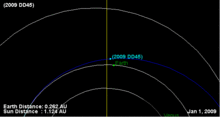2009 DD45
| Designations | |
|---|---|
| Apollo NEO[1] | |
| Orbital characteristics[1] | |
|
Epoch 23 July 2010 (JD 2455400.5) (Uncertainty=3)[1] | |
| Aphelion | 1.495274 AU |
| Perihelion | .98652105 AU |
| 1.240897 AU | |
| Eccentricity | .204994 |
| 504.896 days (1.38233 a) | |
Average orbital speed | .713018 °/d |
| 352.825 ° | |
| Inclination | 13.74520 ° |
| 161.961802 ° | |
| 13.8840 ° | |
| Physical characteristics | |
| Dimensions | 19 ± 4 meters (assumed)[1] |
| 1.2 hr[1] | |
Spectral type | S[1] |
| 25.8 mag | |
|
| |

2009 DD45 is a small Apollo asteroid[1] that passed near Earth at an altitude of 63,500 km (39,500 mi) on 2 March 2009 at 13:44 UTC. It was discovered by Australian astronomers at the Siding Spring Observatory on 27 February 2009, only three days before its closest approach to the Earth.[2][3] Its estimated diameter is between 15 and 23 metres.[1] This is about the same size as a hypothetical object that could have caused the Tunguska event in 1908.[4]
BBC News Online cites the minimum distance as 72,000 km (45,000 mi) (about 1/5 lunar distances).[4][5] 2009 DD45 passed farther away (40 thousand miles versus 4 thousand miles) but was substantially larger than 2004 FU162, a small asteroid about 6 m (20 ft) across which came within about 6,500 km (4,000 mi) in 2004,[4] and is more similar in size to 2004 FH. With an uncertainty parameter of 3, the asteroid is predicted to make its next close encounters with Earth on 2056-Feb-29 and 2067-Mar-03.[1]
References
- ↑ 1.0 1.1 1.2 1.3 1.4 1.5 1.6 1.7 1.8 "JPL Small-Body Database Browser (2009 DD45)" (last obs. used 2009-03-06). Jet Propulsion Laboratory. Retrieved 2010-09-26.
- ↑ Kelly Beatty (2009-03-01). "Space Rock 2009 DD45 Buzzes Earth". Sky & Telescope. Archived from the original on 6 March 2009. Retrieved 2009-03-04.
- ↑ Victoria Jaggard (2009-03-02). "Surprise Asteroid Just Buzzed Earth". National Geographic Society. Archived from the original on 4 March 2009. Retrieved 2009-03-04.
- ↑ 4.0 4.1 4.2 "Space rock makes close approach". BBC News Online. 2009-03-03. Archived from the original on 4 March 2009. Retrieved 2009-03-03.
- ↑ Scientific American, May 2009 issue, listed the minimum distance as 72,200 km (p. 26)
External links
- 2009 DD45 at the JPL Small-Body Database
- Universe Today article on 2009 DD45
- 100 meter asteroid will pass Earth Monday!, Phil Plait's Bad Astronomy blog
- NEO Asteroid 2009 DD45 from Canberra on YouTube